CLIMATE CHANGE AND HEALTH

Climate indicators Linda Marsa wrote in Discover magazine, “Rising temperatures — an average increase in the United States of 2 degrees Fahrenheit over the past 50 years — are exacerbating a whole range of modern ills, including pollution, urban crowding, and inadequate medical facilities. Asthma, allergies, and heart disease get worse under the stress of heat and smog. Cities are particularly affected due to air pollution and what experts now call “urban heat islands,” created as asphalt, pavement, and buildings concentrate heat. In developing countries, extreme weather could drive even more people away from farms and into overcrowded shantytowns. “People are moving to these giant urban slums without adequate sanitation, which are perfect mosquito breeding zones,” Petersen says. At the same time, violent hurricanes, floods, and fires — likely symptoms of climate change — could stretch the limits of many countries’ health-care systems. Look at Pakistan, which was ravaged by the worst monsoon-induced floods in its history last August. The flooding displaced more than 17 million people and triggered outbreaks of cholera. [Source: Linda Marsa, Discover magazine, December 2010]
“Climate change is the biggest global health threat of the 21st century,” a team of British scientists and academics wrote in The Lancet in 2009. The threat has been completely neglected, marginalized, and ignored by the global health community and by policymakers, according to pediatrician Anthony Costello, director of University College London’s Institute for Global Health and lead author of the report. “Yet in terms of our well-being, in terms of our survival over the next 100 years, it is absolutely the top political issue involving the ecosystem that we should be talking about,” he adds.
Confronting new diseases will require greatly expanded surveillance networks... In the United States, some of the most alarming outbreaks are occurring in the suburbs, where rising temperatures may help explain the spike in such tick-borne illnesses as babesiosis; hga (human granulocytic anaplasmosis), a potentially lethal flulike infection; and Lyme disease, the most common vector-borne disease in this country. The black-legged ticks that spread Lyme-causing bacteria are hardy survivors found on parts of the West Coast, in the Midwest, and on the East Coast from at least South Carolina right up into Canada. Lone star ticks, abundant in the South, transmit infections like tularemia, ehrlichiosis, and a Lyme-like illness not yet identified. They have been spotted as far west as Texas and Oklahoma and along the eastern seaboard as far north as Maine.
Noninfectious diseases like allergies and asthma, already epidemic in America, are likely to get a boost from rising temperatures as well. Indeed, at least 50 million Americans already suffer from these ailments; asthma alone affects one in nine American adults and nearly 10 percent of children. And their incidence is already climbing, probably in response to climate changes. Both air pollution and pollen, two of the chief culprits behind asthma and allergies, intensify as temperatures increase. Ozone smog is created when sunlight cooks pollutants in the atmosphere. When the air heats up, more ozone is produced. Pollens, released into the air by flowering plants, trees, and grasses, appear earlier and for a longer period of time under warmer conditions”.
Health Effects of Higher Temperatures
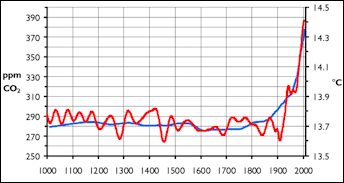
CO2 Temperature From June to August in 2011, in the United States, blistering heat set 2,703 daily high temperature records, compared with only 300 cold records during that period. That made it the hottest summer in the U.S. since the Dust Bowl of 1936, according to Weather Underground Meteorology Director Jeff Masters. And then there was Russia in 2010.
Linda Marsa wrote in Discover magazine, In the summer of 2010 Russia wilted under the most intense heat wave in 130 years of record-keeping there, with daily highs in Moscow exceeding 100ºF, compared with the normal summer average of 85º. In the countryside, severe drought ignited wildfires that smothered the city in poisonous smog for six straight days. The combination of unprecedented heat, dryness, and suffocating haze doubled death rates to an average of 700 people a day. [Source: Linda Marsa, Discover magazine, December 2010]
“It was over 100º every day for a couple of weeks, and you could barely see a block away if you were walking down the street,” Marco North, creative director of Bittersweet Moscow, a local art studio, told Discover. “People were walking around with surgical masks on, and I had to keep the windows of my apartment tightly shut. I bought two oscillating fans — which normally sell for about $10 — for hundreds of dollars apiece. And I had to fight people to buy them.”
There's an 80 percent chance that the killer Russian heat wave of 2010 would not have happened without the added push of climate change, according to a study published in the Proceedings of the National Academy of Sciences I .
“This is a snapshot of what is on the horizon both in the United States and abroad,” Marsa wrote. “Over the next century, the global thermostat will probably ratchet up another 2 to 12 degrees on average, according to a 2009 report from the U.S. Global Change Research Program. This shift will mean more extremely hot summer days affecting every part of the country. By 2080 it could be above 90º some 120 days a year in Kansas — longer than the entire summer. Much of Florida and Texas could be above 90º for half the year, and many parts of the country, especially the Sun Belt, could have more than two months each year with 100º weather.
Sweltering temperatures in the 110º -120º range could soon become commonplace. The sizzling weather in Chicago in 1995, which claimed more than 700 lives, was just a prelude, according to the same government report. If greenhouse-gas emissions are not curtailed, heat-related deaths in Chicago alone could rise tenfold by the end of the century, government scientists say, and the Midwest and the South could swelter with triple-digit temperatures for much of the year, leading to more heatstroke and other heat-related illness and death.
Intense heat waves will become more common over the next few decades, according to a 2009 report released jointly by the National Wildlife Federation and Physicians for Social Responsibility. That increase will elevate the risk of heat-related deaths. Heat waves swept across Europe in 2003 and 2005 and killed more than 70,000 people. The 2003 event was “one of the deadliest climate-related disasters in Western history,” according to researchers at Stanford University and the University of Washington. (Rising temperatures also mean fewer deaths from the cold, but heat is by far the greater danger. A 2007 study in Occupational and Environmental Medicine found that cold snaps increase death rates by 1.6 percent, while heat waves trigger a 5.7 percent jump. Heat waves also disrupt food production in tropical regions; there is no equivalent danger from cold.)
Climate Change Is Making Winter Ice More Dangerous
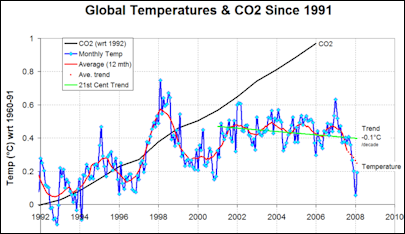
Global Temperatures since 1991 Research published in the journal PLoS One in November 2020 describes a link between climate change and winter drownings and that reported drowning deaths are increasing exponentially in areas with warmer winters. The study examined drownings in 10 countries in the Northern Hemisphere. The largest number of drownings occurred when air temperatures were just below the freezing point, between minus 5 degrees Celsius and 0 Celsius (between 23 degrees Fahrenheit and 32 Fahrenheit). [Source:Veronica Penney, New York Times, November 21, 2020]
Veronica Penney wrote in the New York Times: “Some of the sharpest increases were in areas where Indigenous customs and livelihood require extended time on ice. Across the countries studied, children under the age of 9 and teenagers and adults between 15 and 39 were the most vulnerable to winter drowning accidents.
“Sapna Sharma, an associate professor of biology at York University in Toronto and a lead author of the study, said people did not always realize how global warming is increasing the risks that come with winter traditions like skating, ice fishing and snowmobiling. “I think there’s a disconnect between climate change and the local, everyday impacts,” Sharma said. “If you think about climate change in winter, you’re thinking about polar bears and ice sheets, but not about these activities that are just ingrained in our culture.”
“Those ingrained habits can lead to a false sense of security, Sharma said. “It might be minus 20 Celsius today and tomorrow and the weekend, but last week it was 15 Celsius,” she said. “Well, we might have forgotten as individuals that it was warm and sunny last week on a Tuesday, but the ice didn’t forget.”
“The lack of sustained cold, which leads to more freeze-thaw events, is crucial. Each time ice thaws and refreezes, it gets a little weaker — and it can stay that way for the remainder of the cold season. “Milder temperatures mean that the ice is not as thick, or not as solid as it would otherwise be,” said Robert McLeman, a professor of geography and environmental studies at Wilfrid Laurier University who was not involved in the study. “And so people are going out onto it and not realizing that the ice is rotten.”
“The authors compared death records and temperature data in Canada, Estonia, Germany, Latvia, Finland, Russia, Sweden, Italy, Japan and the northern United States. They analyzed about 4,000 total records over a span of 26 years, though the time period varied depending on the available data in each country. “The researchers found that more cold-weather drownings occur in spring, when daily low temperatures increase too much to support stable ice structures. At the same time, those warmer temperatures make it more enjoyable to spend time outdoors, meaning more people are spending time on ice.
“Northern Canada and Alaska have higher rates of drowning, even in very cold temperatures. Sharma said that is probably because people there simply spend more time on the ice. Indigenous communities close to the Arctic rely on waterways for food and transportation, which means more time on the ice in winter and an increased risk of drowning.
Climate Change, Allergies and Respiratory Diseases
High levels of carbon dioxide is likely to increase the growth of ragweed and other pollen-producing plants and make life more uncomfortable for allergy sufferers. Higher temperatures at ground level increase the amount of ozone, a major component of smog, creating problems for people with asthma and respiratory illnesses.
Linda Marsa wrote in Discover magazine, “New research shows that hotter weather coupled with higher concentrations of carbon dioxide in the air prompt flowering plants to produce pollen that is far more noxious than pollen of the past. U.S. Department of Agriculture scientists grew weeds in three sites: an organic farm in western Maryland, a park in a suburb of Baltimore, and in downtown Baltimore, which is choked with smog and about 3 to 4 degrees warmer than the surrounding countryside because of the urban heat island effect. The weeds in the hotter, CO2-enriched environment grew to nearly twice the size of plants on the farm — up to 12 feet versus 6 to 8 feet in the country — and generated not only more pollen but, according to other research, more-allergenic pollen.” [Source: Linda Marsa, Discover magazine, December 2010]
Further evidence comes from a study done by a group of European scientists last year. Looking at hospital admission data from 12 major cities, including Dublin, London, Barcelona, and Rome, they found that for every 1 degree Celsius (about 2 degrees Fahrenheit) of temperature increase, hospitalizations from respiratory and asthma-related illness rise by as much as 4.5 percent among the elderly. And the more people breathe polluted air and pollen, the worse their symptoms and the likelier they are to develop more allergies.
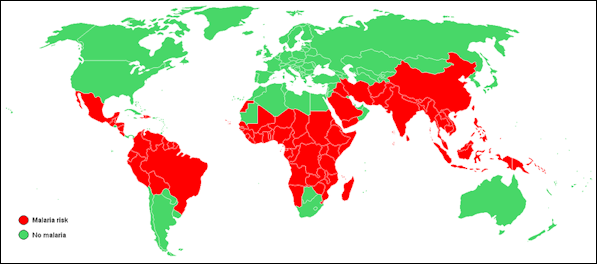
Malaria map
Climate Change and Disease
There are serious concerns that climate change will result in an increase in deaths and sickness related to the consequences of heat waves and the spread of diseases like malaria and dengue fever. Some worry that if climate change increases significantly mosquitos that carry dengue and yellow fever and other diseases could move north into Japan, Europe and North America. The spread of water-borne diseases could become just as much of problem in developed countries as it is in developing ones. Between 1948 and 1994 in the United States, heavy ran was linked with more than half the nations outbreaks of water-borne disease.
Global warming is already being blamed for the spreading of disease. Mosquitos that carry dengue and yellow fever were once limited to places below 3,300 feet in tropical regions. Now there are found as high a s 7,200 feet and in temperate regions such as the Netherlands where they hadn’t been found before. Malaria is appearing in a number of highland areas of Africa that had traditionally been immune from the disease. In Sweden the northward migration of ticks has been blamed for an increase in tick-born encephalitis since the 1980s. In other parts of the world higher water temperatures have been linked to cholera outbreaks.
According to a WHO study released in November 2003, “climate change may already be causing 160,000 deaths a year.” Most of the deaths are from malnutrition, diarrhea, malaria, floods and droughts in tropical areas. This figure is expected to double by 2030. According to “The Sting of Climate Change “, a 2008 report by the Sydney-based Lowry Institute since the 1970s climate change has caused 150,000 more deaths every year — with half of them in Asia and most resulting from the spread of diseases like malaria and dengue fever. That report predicted that by 2085 half the world’s population will be at risk from dengue fever and 60 percent will be in malaria -endemic zones.
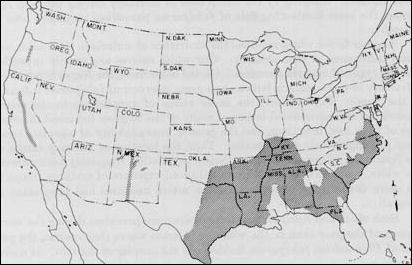
malaria was in the U.S. until the 1930s Flooding could cause sanitation problems and increased risks of disease like cholera and dysentery. Scientist predict that as the climate warms heavy rainfalls will increase and this will increase poor sanitation as sewers spillover more frequently and contaminate water, making the spread of water-borne diseases more likely. Higher lake and ocean temperatures will allow bacteria, parasites and algae to grow more vigorously. Harder rains will also mean more pools of water where disease-carrying mosquitos can thrive.
Linda Marsa wrote in Discover magazine,”Over the past three decades, the World Health Organization has identified at least 30 new or resurgent diseases around the world. Louis Magnarelli, a medical entomologist and director of the New Haven — based Connecticut Agricultural Experiment Station, suspects that subtle changes in the climate may be behind the spread. Warmer winters, wetter and earlier springs (which expand the time during which ticks can pick up the disease), increased humidity, and greener environments can all contribute to the increased incidence of ticks and the growing populations of hosts, including large mammals like white-tailed deer; smaller ones such as white-footed mice, the principal carrier of Lyme disease; and many species of birds. “We’re seeing more disease — the number of cases being reported is very conservative — and ticks are expanding their geographic range,” Magnarelli says. [Source: Linda Marsa, Discover magazine, December 2010]
The increased mobility of the modern world makes the situation worse. Scientists say that the most virulent version of Lyme disease may have reached our shores from Europe by ship. Infected individuals or parasitic hitchhikers can now go anywhere in the world in less than 24 hours and deliver reservoirs of malaria, dengue, or Chikungunya fever to newly temperate ecosystems. “When you have this combination of tremendous global transport of people and goods, changing ecosystems, and changing climate,” Balbus says, “it raises the possibility of emerging diseases.”
Dengue Fever in the United States

Linda Marsa wrote in Discover magazine, “It was a hot, sticky day when patient zero arrived at a local hospital in Brownsville, Texas, in June 2005. Her body was racked with chills, she couldn’t stop vomiting, her blood pressure was perilously low, and she was passing blood in her urine. Clueless as to the cause, doctors pumped her up with fluids to treat dehydration, dosed her with antibiotics, and sent her home. But when blood tests and clinical evaluation were done with the help of the regional Texas Border Infectious Disease Surveillance project, a surprising culprit was unmasked: dengue hemorrhagic fever, a deadly viral disease usually regarded as a risk only in the tropics. [Source: Linda Marsa, Discover magazine, December 2010]
Long thought eradicated in the United States, dengue is roaring back. There had been prior cases of the disease’s milder cousin, classic dengue fever, in Brownsville, a bustling metropolis of about 140,000 people at the southernmost tip of Texas on the Gulf coast. But this was the first well-documented case of the more serious form of dengue infection, hemorrhagic fever, in a Texas resident infected in the continental United States. It is unlikely to be the last. From 1995 to 2005, some 10,000 cases were reported in the United States and the Texas-Mexico border region. The Centers for Disease Control and Prevention (CDC) believes that many cases are never counted, so these figures may be a vast underestimate.
A range of factors influence the spread of the dengue virus, but rising global temperatures may be the most important of all. Like many tropical diseases, dengue is spread by mosquito bites, and mosquitoes are exquisitely sensitive to climate. Frost kills both adults and larvae, which is why the disease hadn’t previously been able to get a foothold in the United States. With the advent of warmer winters, there is nothing holding the insects back. As a result, the two species of mosquito capable of transmitting dengue fever — Aedes aegypti and Aedes albopictus, also called the Asian tiger mosquito — have substantially expanded their habitat range since the middle of the 20th century. They are spreading into temperate areas in at least 28 states in this country, even as far north as New York and New Hampshire, according to a 2009 report by the Natural Resources Defense Council (NRDC).

Hotter, more humid weather shortens mosquito breeding cycles. Heat speeds up the incubation of the dengue virus, making it infectious much sooner and for more of the insect’s life span. Female mosquitoes bite more frequently when the thermostat rises. Climate change is likely to usher in an era of more extreme weather, including the heavy rains and flooding that create ideal mosquito breeding grounds. And dengue is far from the only risk. Along with mosquitoes, ticks, mice, and other carriers are likewise surviving milder winters and fanning out across the country, spreading an encyclopedia of pathogens: Lyme disease, Rocky Mountain spotted fever, equine encephalitis, St. Louis encephalitis, anaplasmosis, and babesiosis, a once uncommon malaria-like infection in the United States. “Vector-borne diseases are rapidly changing their distribution and frequency,” says medical entomologist Lyle Petersen, director of the Division of Vector-borne Diseases for the CDC.
Patient zero recovered. But Brownsville’s public-health officials were alarmed at the possibility of a deadly dengue epidemic because there is no vaccine to protect against it or medicine to cure it. The grave worry was that “if dengue moves into a population that hasn’t experienced it and has no natural immunity, we are going to see more severe disease,” says Susan Fisher-Hoch, an epidemiologist at the University of Texas School of Public Health in Brownsville who was involved in studies of dengue in her state”. “The way we live hermetically sealed in our houses — with screens on the windows and air-conditioning — protects us enormously. But what about those who don’t live well — the people in trailer parks sitting on their porches surrounded by mosquitoes?”
Despite the thousands who have been stricken, most Americans are not aware of dengue — yet. Epidemic outbreaks throughout Latin America — in Brazil, Mexico, Honduras, Paraguay, Costa Rica, Bolivia, and Cuba — now hit nearly a million people annually. Inexorably, the disease has been extending its reach farther north. Cases are being reported with increasing frequency in Puerto Rico and Florida and now number in the thousands there. Dengue cases have been confirmed in almost every state and as far up as Maine, Minnesota, and Washington. The numbers cast a foreboding light on the range of the aggressive Asian tiger mosquito, which transmits not only dengue but Chikungunya fever, a particularly nasty infection that causes excruciating joint pain.
Climate Change and West Nile Virus
Linda Marsa wrote in Discover magazine, “The synergy of warmer temperatures, extreme weather (both wet and dry), and increased mobility is what enabled the West Nile virus to become entrenched in North America. The deadly pathogen first emerged in the West Nile district of Uganda in 1937, then lay dormant for about 20 years before it cropped up again in Israel in the 1950s and reappeared in Romania in 1996. Each of these outbreaks occurred after an unusually dry, hot spell, according to research by Israeli scientists, creating the perfect incubator for Culex pupiens, a common house mosquito that transmits West Nile.” [Source: Linda Marsa, Discover magazine, December 2010]
In 1999 the virus was identified in New York City, possibly reaching our shores inside a mosquito stowaway on an international flight, but more likely carried in the bloodstream of someone already infected. Once again, that summer was unusually hot and dry in New York, and the high temperatures helped West Nile gain a foothold. “By mid-August there were 10 days over 100 degrees that were followed by heavy rains and flooding, which made the mosquito populations explode,” recalls Tracey McNamara, a veterinary pathologist who was head of pathology for the Wildlife Conservation Society at the Bronx Zoo during the initial West Nile outbreak.
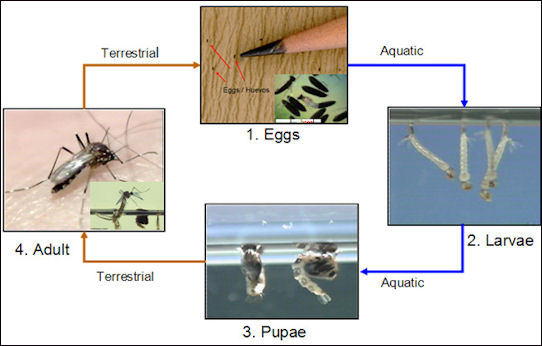
dengue fever lifecycle
Stagnant pools of water teeming with mosquitoes lured thirsty birds, and they became infected, transmitting the West Nile virus. “The virus just swept through the bird population at the zoo, killing crows, flamingos, even bald eagles,” McNamara says. Within a year, 62 people were stricken with West Nile disease and seven were dead. When another hot, dry summer hit in 2002, the disease spread like wildfire across the United States and into Canada. Since then, more than 30,000 cases of West Nile disease have been reported in the United States. Some have been left severely disabled by a pathogen that attacks the nervous system, and more than 1,000 have died.
“We think we’re protected by the Atlantic and the Pacific oceans, but the reality is that we’re an eight-hour plane ride away from someone who has just flown into London from Africa,” says medical toxicologist James Diaz, program director of environmental and occupational health sciences at Louisiana State University School of Public Health in New Orleans. “And don’t forget we lost millions of birds as West Nile marched across the United States, and we lost untold numbers of horses and other animals, too.”
“Could malaria and other exotic diseases that today rarely occur in the industrialized nations of North America and Europe follow a similar path? Diaz thinks so. He points out that competent mosquito vectors for dengue and malaria are already present in the United States. “They’re simply awaiting an opportunity to transmit these diseases locally between arriving infected airline travelers and nearby residents,” he says. [Source: Linda Marsa, Discover magazine, December 2010]
Many of these diseases can get imported and established before we’re even aware of them, adds Kerry Clark, an expert in vector-borne diseases at the University of North Florida in Jacksonville. “We’ll probably have some small focal outbreak from an imported human case that goes unrecognized for a while, and — like a smoldering fire that eventually blows up — the next thing you know, dengue is endemic in the United States,” he says. “West Nile may have been here long before they recognized it — it could have been transmitted among the bird populations for some time, perhaps a year or more, before it reached the infection threshold to spill over and begin affecting humans.”

Global Cooling Map
Combating Disease Risks Created by Climate Change
Linda Marsa wrote in Discover magazine, “The panoply of health risks connected to rising temperatures will require a substantial upgrade in this country’s ability to respond to major outbreaks and regional climate-related disasters. “Our society would be overwhelmed if we were to have multiple Katrinas in a given year,” says Michael McGeehin, director of environmental hazards and health effects for the CDC’s National Center for Environmental Health. “When you have Katrina-like flooding in the northern Mississippi River, what happens to the public-health system? You go back to the 1890s. We go back 110 years because it is so easy to stress the system to the breaking point where we don’t have basic sanitation, uncontaminated food or water, or the ability to control disease.” [Source: Linda Marsa, Discover magazine, December 2010]
Brownsville is becoming a test lab for how this country will respond to the surge of new and renewed infectious diseases. As soon as it became clear that patient zero was a case of indigenous dengue hemorrhagic fever, American health officials began collaborating with counterparts in Matamoros (a Mexican city just across the Rio Grande with a population of nearly three-quarters of a million), dispatching teams to do a blood-sampling survey to uncover the overall extent of dengue infections. They knocked on doors throughout Brownsville, in Matamoros, and in the colonias, the squalid shantytowns that line the border. There, residents live in cramped quarters, with poor sanitation, no running water, and no paved roads. The old tires, rusty buckets, and plastic containers that litter the encampments collect stagnant water, making them ideal breeding grounds for mosquito larvae.
Health officials discovered that nearly 1,300 people were infected with dengue fever as of the end of August 2005. The results of a random survey were even more startling: The officials found that 76 percent of the residents surveyed in Matamoros had dengue antibodies, indicating prior exposure to the virus. They also found evidence of past dengue infection in nearly 40 percent of those tested in Brownsville. Of the 24 Brownsville residents who had never traveled outside the United States, 25 percent tested positive for dengue — which meant the illness was now firmly entrenched here. Patient zero was merely the visible manifestation of a tropical disease that had already put down roots in the United States.
A visit to Brownsville offers a glimpse of what it is like to be at war with invasive disease. Mosquito traps are all over town, and vector-control teams are routinely dispatched to mosquito hot spots to spray insecticides and apply larvicides after heavy rainfall or in response to complaints. Neighborhoods on both sides of the border have been blanketed with bilingual pamphlets containing mosquito prevention tips, educational seminars are being conducted at local schools, and training sessions at medical centers teach doctors how to detect and treat dengue. “Physicians coming into the area aren’t familiar with dengue, and tropical diseases need to be part of their diagnostic workups,” says Arturo Rodriguez, the Brownsville public-health director. “We also meet regularly with our counterparts in Mexico and have jointly made dengue one of our top priorities in health.”
These collaborative efforts are part of a larger campaign by the CDC, which is beefing up disease surveillance throughout the United States to prevent lethal pathogens like dengue from taking root here. The agency has partnered with the Mexican Secretariat of Health to establish the Border Infectious Disease Surveillance network to identify and control outbreaks early. “We take the potential of climate change very seriously, and we’re at the beginning of a long-term process,” Lyle Petersen says. “We’ve been building up our national surveillance network for these diseases, which was a huge task. Now we’re developing specialized sites around the country to home in and investigate in much greater depth.”
There are hopeful signs on other fronts. Cities that anticipate hotter weather, like Chicago, Philadelphia, Milwaukee, and St. Louis, have launched programs to prevent loss of life during heat waves. In 1999, when Chicago sweltered under another spell of record-breaking temperatures, strongly worded warnings were issued immediately, more than 90 cooling centers were opened, and over 30,000 people at greatest risk were personally contacted. The city also embarked on a program to reduce the urban heat island effect by introducing more parks and trees, painting roofs so they would reflect the sun, and planting gardens on roofs so they wouldn’t absorb heat.
Image Sources: World Meteorological Organization; National Oceanic and Atmospheric Administration (NOAA), Wikimedia Commons
Text Sources: World Meteorological Organization; National Oceanic and Atmospheric Administration (NOAA), New York Times, Washington Post, Los Angeles Times, Times of London, Yomiuri Shimbun, The Guardian, National Geographic, The New Yorker, Time, Newsweek, Reuters, AP, Lonely Planet Guides, Compton’s Encyclopedia and various books and other publications.
Last updated April 2022
